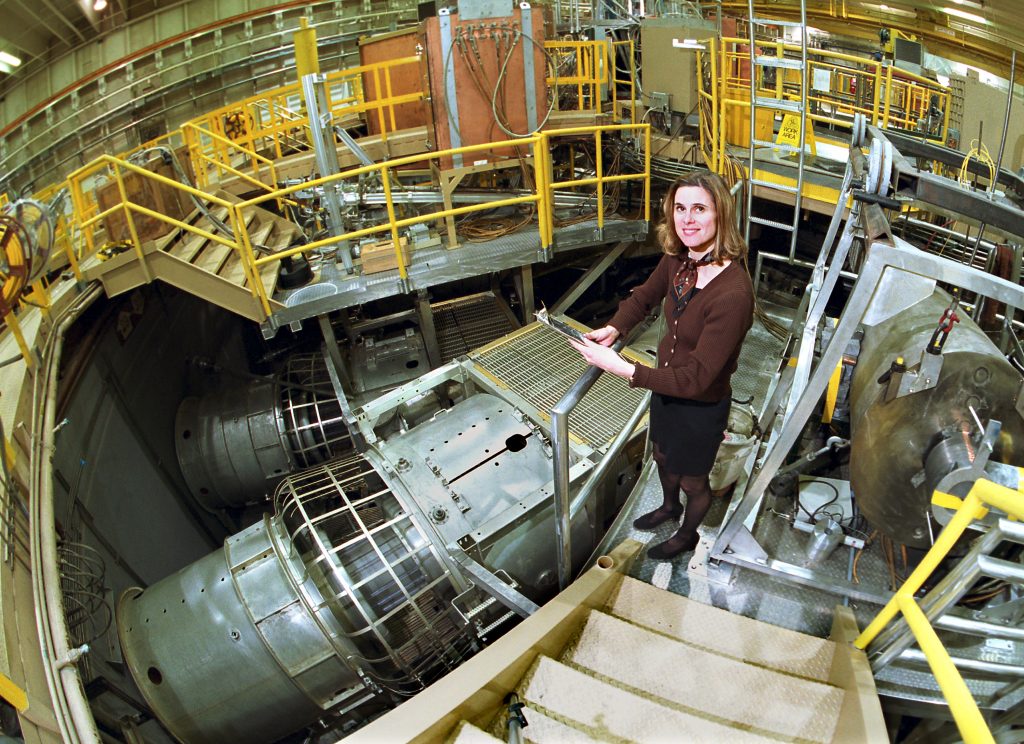
Download 300dpi JPEG image, ‘douglas.jpg’, 2.6M (Media are welcome to download/publish this image with related news stories.)
ALBUQUERQUE, N.M. — The computer simulations of Melissa Douglas help design the targets of Sandia National Laboratories’ powerful Z machine.
Tests on Z provide information about nuclear explosions, produce data for astronomers about the effects of stars on matter, and continue to come closer to the temperatures of controlled nuclear fusion — a feat which, if achieved, could lead to unlimited power for humankind.
For her work in improving Z’s output, Douglas, a researcher at the Department of Energy facility, will receive the 1999 Early Achievement Award from the Institute of Electrical and Electronics Engineers (IEEE)’s Nuclear and Plasma Sciences society.
The award — a plaque and money — is given for valuable contributions to plasma physics made within the first ten years of completing a PhD.
Douglas’ doctorate from the University of New Mexico was awarded in 1995.
Z, housed in an inconspicuous building about the size of a high school gymnasium in the high desert of New Mexico, directs brief powerful bursts of electricity at targets about the size of a spool of thread. The spool contains wires almost too thin to see. The jolt of electricity vaporizes the wires. The magnetic field, created as the electricity shoots through, pinches the just-formed ionic vapor at a speed that is a considerable fraction of the speed of light. When the ions run out of room within a few centimeters, they stop suddenly, releasing heat in the form of X-rays. For a few trillionths of a second, the machine when fired reaches the temperature of the surface of the Sun and a power output (in X-rays) equal to approximately 80 times that of all the world’s electrical generators.
Douglas was part of a small team that created one of the Z machine’s greatest climbs in output in a single shot. By designing the first nested arrangement of target wires (wires in two concentric rings) for Z, on Jan. 16, 1998, her optimal configuration resulted in more than a 30 percent increase in power over that of a standard single array.
“Melissa uses existing computer programs that work in two dimensions to help us better understand what happens in z-pinch experiments. She also shows us the most advantageous path to enhance performance in the future,” says Jeff Quintenz, director of pulsed power sciences at Sandia. “Because of her work, we will know better how to design new three-dimensional algorithms to further our understanding of these complicated dynamic systems.”
Sometimes, wearing high heels, skirt, checked blazer, and — dangling from around her neck — field binoculars that suggest bird-watching, she strides along grated metal catwalks above thousands of gallons of oil and water at Z. Surrounded by frogmen in wet suits emerging from insulating tanks and technicians in overalls and boots aligning sensors, she kneels on the grated catwalk at the very edge of the 12-foot-diameter, 20-foot-deep central vacuum chamber at the heart of Z.
Intently, she stares down through her binoculars to make sure the arrangement of Z’s tiny target and diagnostics are what she designed for this shot.
In November in Seattle, she explained in an invited talk at the High Energy Density Physics and Beams session of the American Physical Society’s Division of Plasma Physics meeting how nested arrays might help Z to better function on longer (i.e., slower) electrical input pulses.
Slower pulses benefit taxpayers because they keep costs down. The slower the pulse, the lower the power-flow risks and therefore less expensive the equipment needed. The problem is that it is difficult to get the same output with a long pulse as with a fast one.